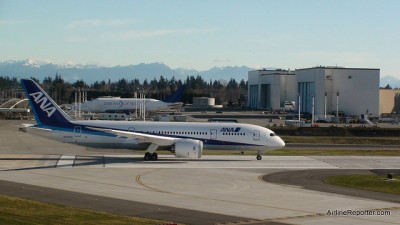For the last day there are been bits and pieces of information coming from Boeing, inside sources and different media outlets on ZA002’s sudden landing due to reported smoke in the cabin. Boeing has just released an official statement putting some of the rumors to rest and explaining what they know of ZA002’s recent emergency landing in Laredo, TX.
Boeing confirms that ZA002 did lose primary electrical power that was related to an on board electrical fire. Due to the loss, the Ram Air Turbine (RAT), which provides back up power (photo of RAT from ZA003) was deployed and allowed the flight crew to land safely. The pilots had complete control of ZA002 during the entire incident.
After their initial inspection, it appears that a power control panel in the rear of the electronics bay will need to be replaced. They are checking the surrounding areas for any additional damages. At this time, the cause of the fire is still being investigated and might take a few days until we have more answers.
At the time of the incident, ZA002 was completing tests of the Nitrogen Generation System, but Boeing does not feel that test was related to the fire. Until Boeing determines the cause, they have postponed all flight tests on the other 787 aircraft. Boeing does not know if this incident will cause the first delivery of the Dreamliner to be pushed back to a later date.

As Boeing’s official statement says, the electrical “fire” was simply the fault of a black box (power control panel) whose wiring or other internal component temporarily gave off some smoke. If that is all it was, it was not a major problem. As long as the airframe wiring was not damaged, it probably wasn’t even Boeing’s fault, but the fault of the supplier that sold the panel to Boeing. Fortunately it happened on a test airplane filled with experts who could have even put out a live fire if necessary. This panel will no doubt be redesigned to prevent future overheat occurrences but Boeing will make sure that this is done quickly.
Regarding the Ram Air Turbine (RAT), it can be dropped into the airstream to supply a limited amount of electrical and hydraulic power after electrical system failure. It continues to supply the Captain’s instruments, engine control computers, fire detection and extinguishing systems, essential communication and flight control functions and other essential circuits such as emergency lighting until landing. The instruments and radio/nav gear will momentarily fail while the RAT is coming up to speed but after that, the Captain will have complete control of the aircraft. During RAT operation, the Copilot’s instruments and navigation gear, etc. will not be powered and the main passenger cabin lighting and galleys, etc. will not operate.
It appears that this was a minor glitch in the extensive test program for the world’s most fuel efficient airliner and that, at no time, was this airplane or its crew in serious danger.
Mr.Elliott,
understand that it was an emergencylanding and not a scheduled landing.You and I do not know for a fact what really happened here ( unless you are working at Boeing – are you…) ?
You guess a lot in your “statement”, “filled with experts”, “redesigned”,”minor glitch”, ” at no time was this airplane or its crew in danger “etc., etc.